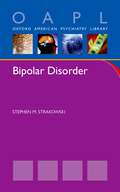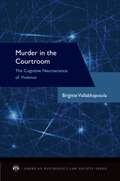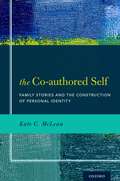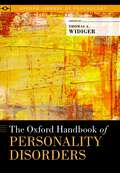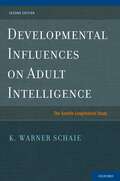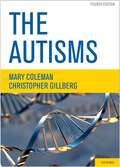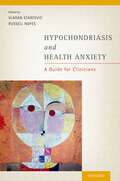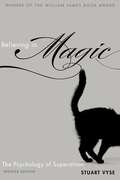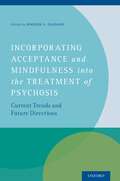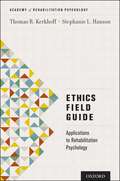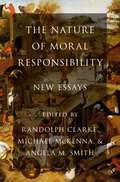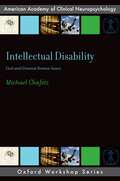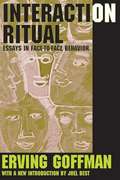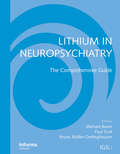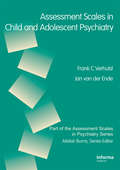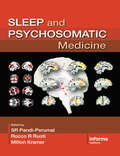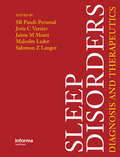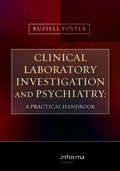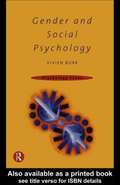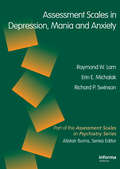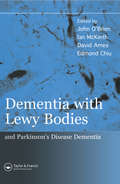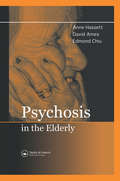- Table View
- List View
Bipolar Disorder (Oxford American Psychiatry Library)
by Stephen StrakowskiBipolar disorder is one of the most common and disabling conditions affecting humankind. It is a leading cause of disability and mortality worldwide, affecting millions of people. The illness is complex and dynamic, so that many individuals are misdiagnosed for years and clinicians struggle with identifying the most appropriate and successful treatment. Because it is complex and common, people suffering from bipolar disorder seek help from clinicians of all types - from psychiatrists, family doctors, gynecologists, and internists to psychologists, social workers and other therapists. For clinicians without significant experience with bipolar disorder, how to manage the condition can be mystifying. Even experienced psychiatrists will frequently find themselves uncertain of the best approach to a given individual with bipolar illness. This pocket-sized guide was specifically written with this diverse group of clinicians in mind. It provides a concise, practical and current overview of bipolar disorder, including making a correct diagnosis, identifying important medical and psychiatric comorbidities, and describing our current understanding of the epidemiology, genetics and neurobiology of the condition. In addition to these topics to provide context, the majority of the book is focused on a programmatic approach toward managing bipolar disorder, including discussions of specific subpopulations, such as children or women who are pregnant. The book may also be of interest for people with bipolar disorder and their families, to help guide treatment seeking and provide education about this sometimes mystifying condition. The author is an internationally recognized and trusted expert in the study and treatment of bipolar disorder, annually named a Best Doctor® and recognized by US News and World Report® as a Top 1% Psychiatrist, whose own extensive clinical experience working with people with bipolar disorder guides this book.
Murder in the Courtroom: The Cognitive Neuroscience of Violence (American Psychology-Law Society Series)
by Brigitte VallabhajosulaAnswers to many legal questions often depend on our understanding of the relationship between the human brain and behavior. While there is no evidence to suggest that violence is the sole result of cognitive impairment, research does suggest that frontal lobe impairment in particular may contribute to the etiology of violent behavior. Murder in the Courtroom presents a comprehensive and detailed analysis of issues most relevant to answering questions regarding the link between cognitive functioning and violence. It is the first book to focus exclusively on the etiology and assessment of cognitive impairment in the context of violent behavior and the challenges courts face in determining the reliability of neuroscience evidence; provide objective discussions of currently available neuropsychological tests and neuroimaging techniques, and their strengths and limitations; provide a methodology for the assessment of cognitive dysfunction in the context of violent behavior that is likely to withstand a Daubert challenge; and include detailed discussions of criminal cases to illustrate important points. Clinical and forensic psychologists and psychiatrists, cognitive neuroscientists, and legal professionals will be able to use this book to further their understanding of the relationship between brain function and extreme violence.
CO-AUTHORED SELF C: Family Stories and the Construction of Personal Identity
by Kate C. McLeanQuestions about identity are perennially intriguing, and vexing, to scholars and non-scholars alike. How do we know who we are? How do we define ourselves? How much are we the agents of our own identities, and how much are we defined by others? In The Co-authored Self, Kate McLean addresses the question of how an individual comes to develop an identity by focusing on the process of interpersonal storytelling, particularly through the stories people hear, co-tell, and share of and with their families. McLean details how identity development is a collaborative construction between the individual and his or her narrative ecology. She argues that family stories play a powerful role in defining identities, for better or for worse; it is through these family stories that the self takes on its earliest and most lasting form. Situating the process of identity development in adolescence and emerging adulthood, she shows through quantitative and qualitative data-with compelling narrative excerpts throughout-the ways in which families both support and constrain identity development by the stories they tell.
The Oxford Handbook of Personality Disorders (Oxford Library of Psychology)
This text provides a summary of what is currently known about the diagnosis, assessment, construct validity, etiology, pathology, and treatment of personality disorders. It also provides extensive coverage of the many controversial changes for the DSM-5, including chapters by proponents and opponents to these changes.
Developmental Influences on Adult Intelligence: The Seattle Longitudinal Study
by K. Warner SchaieAdult cognitive development is one of the most important yet most neglected aspects in the study of human psychology. Although the development of cognition and intelligence during childhood and adolescence is of great interest to researchers, educators, and parents, many assume that this development stops progressing in any significant manner when people reach adulthood. In fact, cognition and intelligence do continue to progress in very significant ways. In this second edition of Developmental Influences on Adult Intelligence, K. Warner Schaie presents the history, latest data, and results from the Seattle Longitudinal Study (SLS). The purpose of the SLS is to study various aspects of psychological development during the adult years. Initiated in 1956 and focusing on a random sample of 500 adults ranging in age from 25 to 95 years old, the SLS is organized around five questions: Does intelligence change uniformly throughout adulthood, or are there different life-course-ability patterns? At what age and at what magnitude can decrement in ability be reliably detected? What are the patterns and magnitude of generational differences? What accounts for individual differences in age-related change in adulthood? Can the intellectual decline that increases with age be reversed by educational intervention? The first edition of the book provided an account of the SLS through the 1998 (seventh wave) data collection and of the associated family study through the 1996 (second wave) data collection. Since that time, Schaie and his collaborators have conducted several additional data collections. These include a further longitudinal follow-up in 2005/06, a longitudinal follow-up and 3rd data collection for the family study in 2003/04, and acquisition of a 3rd generation sample in 2002. Hence, virtually all of the content from the first edition has been updated and expanded, and three new chapters are included on Health Behaviors and Intellectual Functioning, Biological Influences on Cognitive Change, and Prediction of Individual Cognitive Decline. This new edition is a valuable resource for researchers and practitioners specializing in adult development, aging, and adult education, as well as students and faculty in developmental, cognitive, and social psychology, psychiatry, nursing, social work, and the social sciences interested in issues of human aging.
The Autisms
by Mary Coleman Christopher GillbergThe Autisms, written by Mary Coleman and Christopher Gillberg, demonstrates that autism, like mental retardation, is a clinical presentation of numerous different diseases, many with genomic underpinnings. In this ground-breaking work, the authors explain in great detail how to clinically diagnose infants, children, adolescents and adults with autistic behavioral features and their psychiatric and neurological work-ups. This new edition contains several chapters on the associated problems of autism, such as intellectual disability, epilepsy, tics, eating disorders and sleep problems, as well as a chapter on epidemiology that documents the historical increase in autism diagnoses. Several chapters summarize the latest data on neuroanatomy, biochemistry and neuropsychology, while three neurogenomics chapters show evidence suggesting that autism occurs due to genetic errors which cause interruption or misdirection of critical neurodevelopmental circuits in the fetal brain. Completely up-to-date, The Autisms is relevant and necessary reading for researchers and clinicians in neuroscience, neurology, pediatrics, psychiatry, and psychology.
Hypochondriasis and Health Anxiety: A Guide for Clinicians
In the recently updated Diagnostic and Statistical Manual of Mental Disorders (DSM-5), the diagnostic concept of hypochondriasis was eliminated and replaced by somatic symptom disorder and illness anxiety disorder. Hypochondriasis and Health Anxiety: A Guide for Clinicians, edited by Vladan Starcevic and Russell Noyes and written by prominent clinicians and researchers in the field, addresses current issues in recognizing, understanding, and treating hypochondriasis. Using a pragmatic approach, it offers a wealth of clinically useful information. The book also provides a critical review of the underlying conceptual and treatment issues, addressing varying perspectives and synthesizing the current research. Specific topics the text covers include: clinical manifestations, diagnostic and conceptual issues, classification, relationships with other disorders, assessment, epidemiology, economic aspects, course, outcome and treatment. Additionally, the book discusses patient-physician relationship in the context of hypochondriasis and health anxiety and presents cognitive, behavioral, interpersonal and psychodynamic models and treatments. The authors also address the neurobiological underpinnings of hypochondriasis and health anxiety and pharmacological treatment approaches. Based on the extensive clinical experience of its authors, there are numerous case illustrations and practical examples of how to assess, understand and manage individuals presenting with disease preoccupations, health anxiety and/or beliefs that they are seriously ill. It approaches its subject from various perspectives and is a work of integration and critical thinking about an area often shrouded in controversy.
Hypochondriasis and Health Anxiety: A Guide for Clinicians
by Vladan Starcevic And Russell Noyes Jr.In the recently updated Diagnostic and Statistical Manual of Mental Disorders (DSM-5), the diagnostic concept of hypochondriasis was eliminated and replaced by somatic symptom disorder and illness anxiety disorder. Hypochondriasis and Health Anxiety: A Guide for Clinicians, edited by Vladan Starcevic and Russell Noyes and written by prominent clinicians and researchers in the field, addresses current issues in recognizing, understanding, and treating hypochondriasis. Using a pragmatic approach, it offers a wealth of clinically useful information. The book also provides a critical review of the underlying conceptual and treatment issues, addressing varying perspectives and synthesizing the current research. Specific topics the text covers include: clinical manifestations, diagnostic and conceptual issues, classification, relationships with other disorders, assessment, epidemiology, economic aspects, course, outcome and treatment. Additionally, the book discusses patient-physician relationship in the context of hypochondriasis and health anxiety and presents cognitive, behavioral, interpersonal and psychodynamic models and treatments. The authors also address the neurobiological underpinnings of hypochondriasis and health anxiety and pharmacological treatment approaches. Based on the extensive clinical experience of its authors, there are numerous case illustrations and practical examples of how to assess, understand and manage individuals presenting with disease preoccupations, health anxiety and/or beliefs that they are seriously ill. It approaches its subject from various perspectives and is a work of integration and critical thinking about an area often shrouded in controversy.
Believing in Magic: The Psychology of Superstition - Updated Edition
by Stuart A. VyseWhile we live in a technologically and scientifically advanced age, superstition is as widespread as ever. Not limited to just athletes and actors, superstitious beliefs are common among people of all occupations, educational backgrounds, and income levels. In this fully updated edition of Believing in Magic, renowned superstition expert Stuart Vyse investigates our tendency towards these irrational beliefs. Superstitions, he writes, are the natural result of several psychological processes, including our human sensitivity to coincidence, a penchant for developing rituals to fill time (to battle nerves, impatience, or both), our efforts to cope with uncertainty, the need for control, and more. In a new Introduction, Vyse discusses important developments and the latest research on jinxes, paranormal beliefs, and luck. He also distinguishes superstition from paranormal and religious beliefs and identifies the potential benefits of superstition for believers. He examines the research to demonstrate how we can better understand complex human behavior. Although superstition is a normal part of our culture, Vyse argues that we must provide alternative methods of coping with life's uncertainties by teaching decision analysis, promoting science education, and challenging ourselves to critically evaluate the sources of our beliefs.
Incorporating Acceptance and Mindfulness into the Treatment of Psychosis: Current Trends and Future Directions
by Brandon A. GaudianoThere have been exciting new developments in the treatment of schizophrenia and related psychoses in recent decades. Clinical guidelines increasingly recommend that patients be offered evidence-based psychosocial treatments in addition to medications, as such interventions can produce greater improvements and may prevent relapses better compared with medications alone. In parallel with these recent advancements, an evolution in the way cognitive-behavioral therapies are being conceptualized and implemented has occurred due to the incorporation of novel strategies that promote psychological processes such as acceptance and mindfulness. While there are a variety of acceptance/mindfulness approaches being developed to address psychosis, there is not currently a dominant approach. In Incorporating Acceptance and Mindfulness into the Treatment of Psychosis, Brandon Gaudiano brings together the researchers and clinicians working at the cutting edge of acceptance/mindfulness therapies for psychosis to compare and contrast emerging approaches and discuss them within the context of the more traditional cognitive-behavioral interventions. The book includes a section that focuses on six distinct treatment models that incorporate acceptance and mindfulness strategies for psychosis and a section that provides a synthesis and analysis of acceptance/mindfulness approaches to psychosis. It concludes with recommendations for moving the research forward in a constructive and responsible way. This volume will be an important resource for researchers and clinicians interested in gaining a deeper understanding of mindfulness- and acceptance-based approaches and newer psychosocial treatments for severe mental illness.
Ethics Field Guide: Applications to Rehabilitation Psychology (Academy of Rehabilitation Psychology Series)
by Thomas R. Kerkhoff Stephanie L. HansonWe have provided the reader with a resource for applied ethical decision-making for use in clinical, educational, and research settings. The Rehabilitation Psychologist using this book will have a choice of utilizing a Quick Reference guide including pro-con positions regarding possible resolutions and a tabular summary of the varied case examples presented, or making use of more detailed discussion of the ethical concepts pertinent to each case. The most important aspect of this book is inclusion of psycho-social context for each case. This critical factor allows the reader to understand the flow of events and other factors influencing the actions of the key stakeholders, thereby facilitating the ethical decision-making process. The mix of case examples is intentionally broad-based, including ample clinical practice situations, along with challenges found in educational and research settings. There is also variety among the case examples, with two detailed scenarios in each chapter, along with two briefer learning exercises with focused summaries. The reader is challenged to analyze each case and compare the results with the preferred resolution proposed by the authors. Finally, at the end of the book, the reader has access to a list of ethics-relevant reading resources. These resources are divided into categorical domains that will assist with literature searches and further research into applied ethics. The authors trust that this book will serve as a preparatory experience for those psychologists studying for the Rehabilitation Psychology specialty board exam, as well as trainees and clinicians at all levels who desire an applied approach to utilizing the APA Ethics Code as an invaluable guide to everyday professional practice.
The Nature of Moral Responsibility: New Essays
by Randolph Clarke Michael McKenna Angela M. SmithWhat is it to be morally responsible for something? Recent philosophical work reveals considerable disagreement on the question. Indeed, some theorists claim to distinguish several varieties of moral responsibility, with different conditions that must be satisfied if one is to bear responsibility of one or another of these kinds. Debate on this point turns partly on disagreement about the kinds of responses made appropriate when one is blameworthy or praiseworthy. It is generally agreed that these include "reactive attitudes" such as resentment and gratitude, but theorists disagree about the nature of these attitudes. They dispute the connections between moral responsibility, desert, and the justification of punishment as well. Many theorists take it that, whatever the appropriate responses are, they are responses to an agent's "quality of will," but there is no consensus on what this comes to. Are the agent's beliefs about the moral status of her behavior what matter, or is it what she cares about, or what she judges important? This volume presents twelve original essays from participants in these debates. The contributors include prominent established figures as well as influential younger philosophers. A substantive introduction by the editors surveys recent debates and situates the contributions within it.
Intellectual Disability: Criminal and Civil Forensic Issues (AACN Workshop Series)
by Michael ChafetzCourts recognize that those who are involved in medico-legal proceedings have a stake in the outcome of their psychological assessment, regardless of whether they are high- or low-functioning individuals. Accounting for the validity of the evaluation in low-functioning examinees is frequently made more difficult by impairment; when evaluating testimony from people with intellectual disability (ID), neuropsychologists and psychologists must acknowledge the differences between the medico-legal evaluation and the clinical evaluation. This book provides helpful guidelines for assessing validity in low-functioning claimants. It charts recent advances in psychological and neuropsychological assessment pertaining to civil and criminal proceedings while examining issues such as validity and motivation, assessments of disability, criminal and civil capacities, capital cases, Miranda waiver cases, and others. In disability cases, the Social Security Administration has had a long-standing policy that prevents neuropsychologists and psychologists from using validity instruments--yet, using this book, an accurate and valid assessment can still be obtained. Evaluators who perform assessments in capital cases will find up-to-date discussions of the Flynn Effect, measurement of intellectual functioning, problems associated with the assessment of adaptive functioning, and the challenge of validity assessment. Miranda waiver evaluations for those with low IQ are discussed concerning issues of capacity measurement, including reading and language analysis for the Miranda advisement in the particular jurisdiction in question. Testamentary capacity is discussed at length, showing how understanding of the legal standard is helpful in guiding the examination. Competency to stand trial, or adjudicative competence, is the main topic in the area of criminal competencies, with exploration of the Dusky standard and the various tests used to evaluate this competence, focusing on individuals with ID.
Intellectual Disability: Criminal and Civil Forensic Issues (AACN Workshop Series)
by Michael ChafetzCourts recognize that those who are involved in medico-legal proceedings have a stake in the outcome of their psychological assessment, regardless of whether they are high- or low-functioning individuals. Accounting for the validity of the evaluation in low-functioning examinees is frequently made more difficult by impairment; when evaluating testimony from people with intellectual disability (ID), neuropsychologists and psychologists must acknowledge the differences between the medico-legal evaluation and the clinical evaluation. This book provides helpful guidelines for assessing validity in low-functioning claimants. It charts recent advances in psychological and neuropsychological assessment pertaining to civil and criminal proceedings while examining issues such as validity and motivation, assessments of disability, criminal and civil capacities, capital cases, Miranda waiver cases, and others. In disability cases, the Social Security Administration has had a long-standing policy that prevents neuropsychologists and psychologists from using validity instruments--yet, using this book, an accurate and valid assessment can still be obtained. Evaluators who perform assessments in capital cases will find up-to-date discussions of the Flynn Effect, measurement of intellectual functioning, problems associated with the assessment of adaptive functioning, and the challenge of validity assessment. Miranda waiver evaluations for those with low IQ are discussed concerning issues of capacity measurement, including reading and language analysis for the Miranda advisement in the particular jurisdiction in question. Testamentary capacity is discussed at length, showing how understanding of the legal standard is helpful in guiding the examination. Competency to stand trial, or adjudicative competence, is the main topic in the area of criminal competencies, with exploration of the Dusky standard and the various tests used to evaluate this competence, focusing on individuals with ID.
Interaction Ritual: Essays In Face To Face Behavior
by Erving Goffman Joel Best"Not then, men and their moments. Rather, moment and their men," writes Erving Goffman in the introduction to his groundbreaking 1967 Interaction Ritual, a study of face-to-face interaction in natural settings, that class of events which occurs during co-presence and by virtue of co-presence. The ultimate behavioral materials are the glances, gestures, positionings, and verbal statements that people continuously feed into situations, whether intended or not. A sociology of occasions is here advocated. Social organization is the central theme, but what is organized is the co-mingling of persons and the temporary interactional enterprises that can arise therefrom. A normatively stabilized structure is at issue, a "social gathering," but this is a shifting entity, necessarily evanescent, created by arrivals and killed by departures. The major section of the book is the essay "Where the Action Is," drawing on Goffman's last major ethnographic project observation of Nevada casinos. Tom Burns says of Goffman's work "The eleven books form a singularly compact body of writing. All his published work was devoted to topics and themes which were closely connected, and the methodology, angles of approach and of course style of writing remained characteristically his own throughout. Interaction Ritual in particular is an interesting account of daily social interaction viewed with a new perspective for the logic of our behavior in such ordinary circumstances as entering a crowded elevator or bus." In his new introduction, Joel Best considers Goffman's work in toto and places Interaction Ritual in that total context as one of Goffman's pivotal works: "His subject matter was unique. In sharp contrast to the natural tendency of many scholars to tackle big, important topics, Goffman was a minimalist, working on a small scale, and concentrating on the most mundane, ordinary social contacts, on everyday life.'"
Interaction Ritual: Essays In Face To Face Behavior (PDF)
by Erving Goffman Joel Best"Not then, men and their moments. Rather, moment and their men," writes Erving Goffman in the introduction to his groundbreaking 1967 Interaction Ritual, a study of face-to-face interaction in natural settings, that class of events which occurs during co-presence and by virtue of co-presence. The ultimate behavioral materials are the glances, gestures, positionings, and verbal statements that people continuously feed into situations, whether intended or not. A sociology of occasions is here advocated. Social organization is the central theme, but what is organized is the co-mingling of persons and the temporary interactional enterprises that can arise therefrom. A normatively stabilized structure is at issue, a "social gathering," but this is a shifting entity, necessarily evanescent, created by arrivals and killed by departures. The major section of the book is the essay "Where the Action Is," drawing on Goffman's last major ethnographic project observation of Nevada casinos. Tom Burns says of Goffman's work "The eleven books form a singularly compact body of writing. All his published work was devoted to topics and themes which were closely connected, and the methodology, angles of approach and of course style of writing remained characteristically his own throughout. Interaction Ritual in particular is an interesting account of daily social interaction viewed with a new perspective for the logic of our behavior in such ordinary circumstances as entering a crowded elevator or bus." In his new introduction, Joel Best considers Goffman's work in toto and places Interaction Ritual in that total context as one of Goffman's pivotal works: "His subject matter was unique. In sharp contrast to the natural tendency of many scholars to tackle big, important topics, Goffman was a minimalist, working on a small scale, and concentrating on the most mundane, ordinary social contacts, on everyday life.'"
Lithium in Neuropsychiatry: The Comprehensive Guide
by Michael Bauer Paul Grof Bruno Muller-OerlinghausenThe definitive textbook on the use of lithium in the treatment of mental disorders, this comprehensive work provides an up-to-date analysis of lithium, including:HistoryClinical applications, including its use for mania, bipolar and schizophrenic disordersUse in special populations, for example in children, the elderly and people with med
Assessment Scales in Child and Adolescent Psychiatry
by Frank C. Verhulst Jan van der EndeMental disorders such as attention-deficit hyperactivity disorder (ADHD), depression, and autism have devastating consequences on the lives of children and adolescents. Early assessment of their mental health problems is essential for preventative measures and intervention. This timely, authoritative guide will be of interest to everyone involved i
Sleep and Psychosomatic Medicine
by S. R. Pandi-Perumal Milton Kramer Rocco R. RuotiPsychosomatic illness can generally be considered as physical illnesses that are believed to be psychologically based; hence they are often referred to as "psychophysiological" disorders. Focusing on the emerging challenges in the fields of both sleep and psychosomatic medicine, Sleep and Psychosomatic Medicine interphases between psychiatry, sleep
Sleep Disorders: Diagnosis and Therapeutics
by Salomon Langer Jaime Monti S. R. Pandi-Perumal Joris VersterOne of the first such volumes in this field, Sleep Disorders: Diagnosis and Therapeutics explores sleep pharmacology and therapeutics. Leading researchers in the area of experimental and clinical and psychopharmacology critically assess the progress in their specialist fields. The book is suitable as an introduction for clinicians and researchers w
Clinical Laboratory Investigation and Psychiatry: A Practical Handbook
by Russell FosterA precise, practical handbook, Clinical Laboratory Investigation and Psychiatry is an invaluable tool that explores day-to-day psychiatric practices and various situations that arise in the field of mental health. This unique and resourceful textbook is a must-have aid for front-line clinicians, psychiatrists, and other professionals working in the
Gender And Social Psychology
by Vivien BurrExplaining theory and research in an accessible but thorough manner, Gender and Social Psychology critically evaluates the contribution that psychology has made to the study of gender, examining key issues such a family roles and parenting, inequalities in education, jobs and pay, and the effects of media representation of the sexes.
Assessment Scales in Depression and Anxiety - CORPORATE: (Servier Edn)
by Raymond W. Lam Erin E. Michalaak Richard P. SwinsonThere are a number of books recently published on assessment scales for depression and anxiety. However, these books are generally more detailed than clinicians require, are specific to one or other condition, or involve specialty populations such as children or geriatrics. To meet the needs of clinicians treating patients with depressive and anxiety disorders, this volume aims to bring together empirically validated assessment scales. In a concise and user-friendly format, Assessment Scales in Depression and Anxiety illustrates the assessment scales used in clinical trials and research studies; shows how to select an assessment scale and to decide which scale to use for a particular clinical situation; and provides sample assessment scales for clinicians to use in their practice.
Dementia with Lewy Bodies: and Parkinson's Disease Dementia
by John O'Brien David Ames Edmond Chiu Ian McKeithFilling a noticeable gap in the market for a new text solely focused on Dementia with Lewy Bodies, this book discusses cutting-edge topics covering the condition from diagnosis to management, as well as what is known about the neurobiological changes involved. With huge progress having been made over the last decade in terms of the disorder
Psychosis in the Elderly
by Anne M. Hassett David Ames Edmond ChiuAcross the spectrum of psychopathology in later life, psychotic symptomatology has been the most neglected, and although literature in this area is increasing, this is the first book to address the need for an overarching framework to examine and understand late-life psychotic phenomena. Exploring the practical and ethical issues that arise when ma
